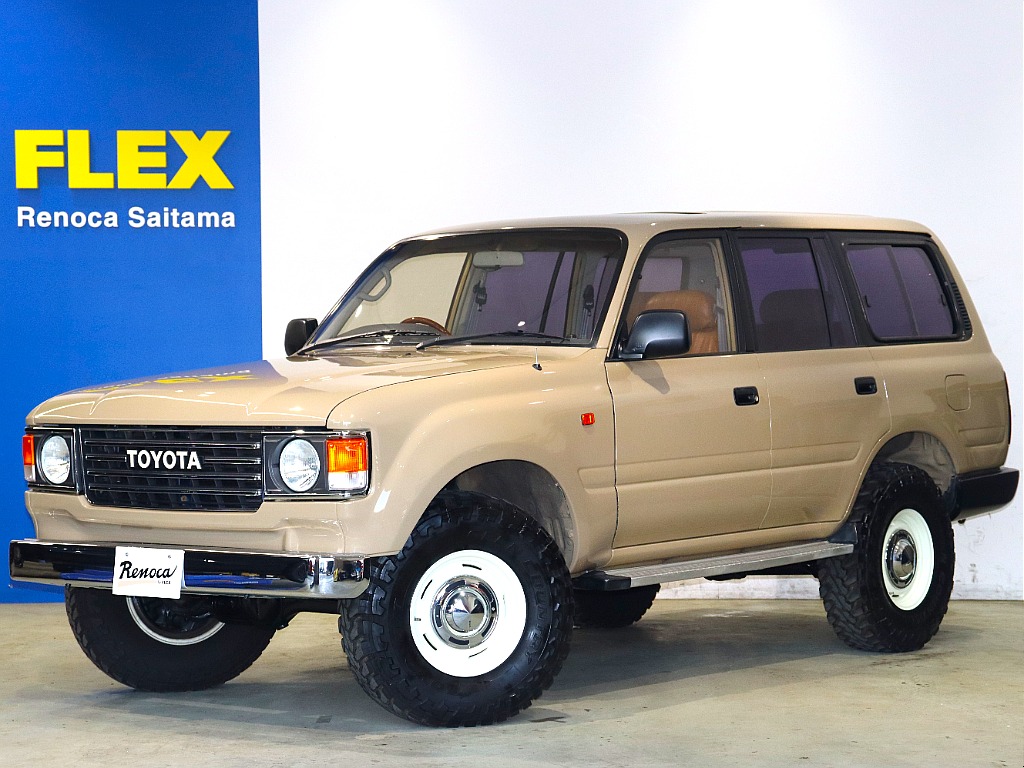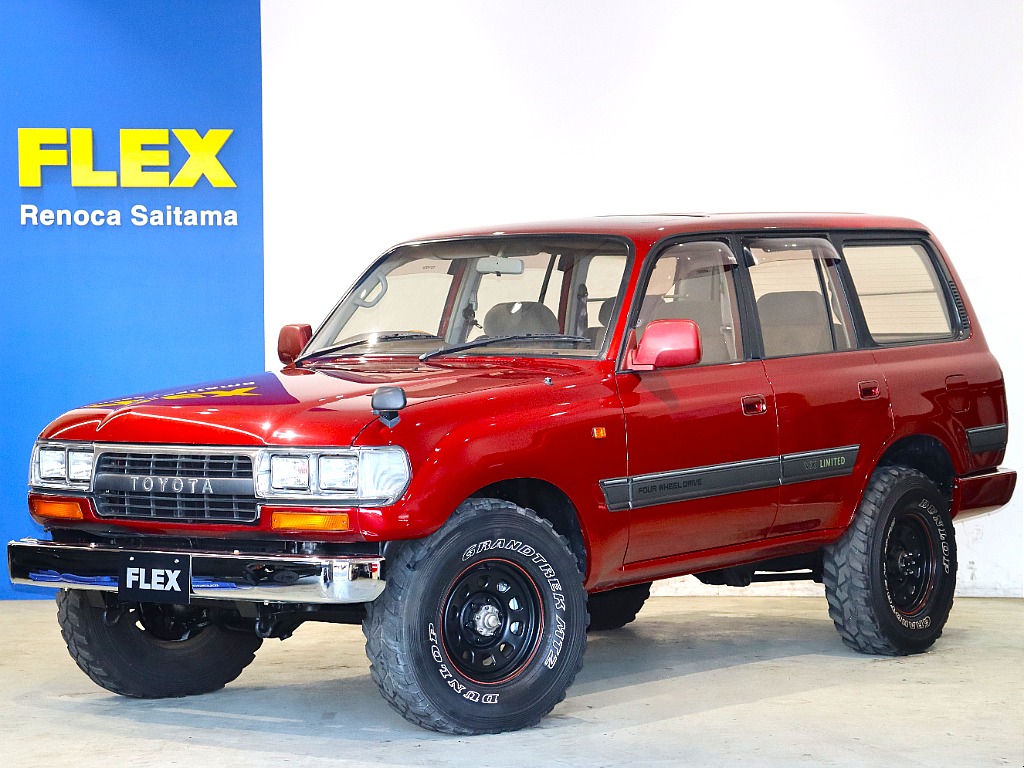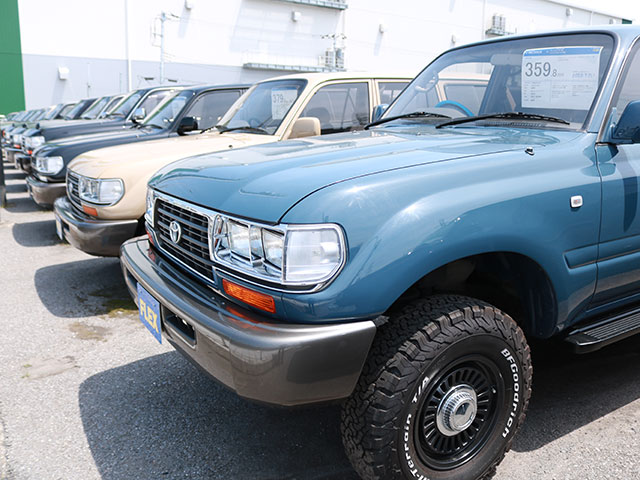What is a Land Cruiser 80?
An innovative full-time 4WD
In December 1989, Toyota announced that the Land Cruiser 80 would be the successor to the Land Cruiser 60. This flagship for the Land Cruiser series was launched in January 1990. Its style and technological innovations are set against the backdrop of a boom in outdoor activities and the growing popularity of 4WD vehicles. It is a major milestone in the long Land Cruiser history.
The Land Cruiser 80 is powered by an inline 6-cylinder gasoline engine, and the same diesel and diesel turbo motors were greatly improved over the previous Land Cruiser 60. The 4WD became full-time with some basic models still having a part-time system, the suspension leaf springs were replaced by coil springs, and the front wheels were given more driving force. Most of the traditional components that make up the Land Cruiser were revamped, like the freewheel hub that cuts off the electric switch.
These changes attracted more buyers, but the Land Cruiser enthusiasts were less than happy with the changes. However, there was a time when the waiting list for the Land Cruiser 80 was more than a year. The model was still popular when it was discontinued in December 1997 and replaced by the Land Cruiser 100.
In the used car market, the number of used diesel engine cars is decreasing due to tighter emission regulations, but gasoline engine cars are still sold in a wide range of model years.
Land Cruiser 80 design and body size comparison with successive models
| Car Model | Land Cruiser 60 | Land Cruiser 80 | Land Cruiser 100 |
|---|---|---|---|
| Sales Period | August 1980 to December 1989 | December 1989-December 1997 | January 1998 to August 2007 |
| Full Length | 187 inches | 196 inches | 193 inches |
| Width | 74 inches | 76 inches | 76 inches |
| Height | 77 inches | 73 inches | 74 inches |
| Minimum Turning Radius | 244 inches | 236 inches | 232 inches |
| Vehicle Weight | 4,211 – 4,894 pounds | 4,828 – 5,093 pounds | 5,049 -5,490 pounds |
| Boarding Capacity | 5~8 people | 5~8 people | 5~8 people |
| Engine Type | Gasoline: 4.2L (straight 6: 2F) / 4.0L (straight 6: 3F-E) Diesel: 4.0L (straight 6: 2H) / 4.0L (straight 6 turbo: 12H-T) / 3.4L (straight 4: 3B) | Gasoline: 4.0L (straight 6: 3F-E) / 4.5L (straight 6: 1FZ-FE) Diesel: 4.2L (straight 6 turbo: 1HD-T, 1HD-FT) / 4.2L (straight 6: 1HZ) | Gasoline: 4.7L (V8: 2UZ-FE) Diesel: 4.2L (straight 6 turbo: 1HD-FTE) |
| 4WD System | Part-time | Full-time/part-time | Part-time |
| MSRP | $14,100-$24,100 | $22,900-$29,000 | $29,000-$41,000 |
*Body size is a typical final model (excluding optional equipment, etc.)
*Vehicle weight does not include optional equipment
*The price when new is the manufacturer’s suggested retail price (tax included) of the final model
Transformation from a work vehicle into a luxury passenger car with enhanced comfort
The Land Cruiser 80 was designed as more of a personal-use vehicle than the Land Cruiser 60. The body corners were rounded, and it was made longer and wider to accommodate passengers and cargo rather than being a rugged workhorse. Since the increase in the body size is directly linked to the roominess in the cabin, the focus is on the overall length and width, but I want to focus on the extension of the Land Cruiser 80’s wheelbase since it has a positive effect on the interior space.
The overall length and width are each increased by several tens of millimeters, but the wheelbase has increased by 120mm/4.8 inches from 2730mm/108 inches for the Land Cruiser 60 to 2850m/112 inches for the Land Cruiser 80. As a result, Toyota succeeded in lowering the position of the second-row seat to the rear while maintaining sufficient space in the cargo area (or the space of the third-row seat). A more spacious, family-friendly interior was created.
This increased size was designed into the Land Cruiser 100, too. The 2850mm/112 inches wheelbase is common to the Land Cruiser 80 and the Land Cruiser 100.
The Land Cruiser 80 had greatly improved maneuverability even on narrow city roads
As the body becomes larger and the wheelbase becomes longer, it generally becomes more difficult for the car to turn in a tight circle. However, although the Land Cruiser 80 has a wheelbase that is 120mm/4.8 inches longer than the Land Cruiser 60, the minimum turning radius is 0.2m smaller, making it easier to handle.
The reason for this is the difference in the front suspension. The Land Cruiser 60 used the traditional leaf springs derived from the first-generation Land Cruiser. The Land Cruiser 80, on the other hand, has a coil spring system, which has a cleaner wheelhouse and allows the front wheels to swing more freely when the steering wheel is turned.
The suspension structure is the same rigid type as the Land Cruiser 60 and 80, but the change from leaf springs to coil springs has made the ride more comfortable. The Land Cruiser 80, which has a large body but is easy to handle, has a sharp turning radius and a comfortable ride, attracted buyers who switched from sedans and wagons.
Changes in Land Cruiser 80 specifications and equipment
December 1989
The Land Cruiser 80 was announced as the successor to the Land Cruiser 60. The production plant was unable to meet the last-minute demand for the Land Cruiser 60 from some fans, so the release was delayed until January 1990.
August 1991
The rear seat belt is now a 3-point type for safety measures. Air conditioning is standard on all models, and the windshield wipers have an intermittent function. In addition, a 4-speaker audio system was installed in some trim levels.
August 1992
Only minor changes are made in the mid-term model. The gasoline engine was changed from the 4.0L 3F-E to the 4.5L 1FZ-FE. The straight 6 remains the same and the power performance is greatly improved as a 24-valve DOHC. The combined AT is electronically controlled and has improved fuel efficiency. At the same time as the suspension is slightly stiffer, the vehicle height is slightly lowered. In terms of safety, 4-wheel ABS is a new option.
May 1993
A new body color was added. The AC system has been changed from refrigerant gas to a more environmentally friendly product.
January 1995
After receiving a minor change, it is now a late model. Toyota changed the design of the front grill and changed the mark from “TOYOTA” to an oval “T” mark. A new body color was added, and in the interior, the instrument panel design was changed to a straight line, and at the same time, the fabric and design of the seats were also improved. An optional driver airbag was offered.
August 1996
All models are equipped with front seat airbags and 4-wheel ABS as standard to improve collision safety.
The Land Cruiser 80 has undergone two major-minor changes in its roughly eight years of production, with at least one minor change in between. A particularly big change is still a minor change, and when choosing a used car, you should check the difference before and after that point.
Minor changes in 1992 replaced the gasoline engine with a newly developed one, and in 1995 the interior design, including the instrument panel, was upgraded and collision safety measures were greatly advanced. As expected, it has been nearly 32 years since its introduction and nearly 25 years since production ended, and in addition to the impact of emissions regulations, the number of early models, especially until the first minor change, has decreased. It is realistic to find a gas or diesel-powered car with full safety equipment from the mid-term onwards.
Land Cruiser 80 model explanation
Four models, gasoline, and turbo diesel engine
There are four models in the Land Cruiser 80 lineup, from bottom to top: STD (standard), GX, VX, and VX Limited. As with other Land Cruisers, the models are determined by the equipment and specifications depending on the model year.
The 4.5-liter straight-6 gasoline and the 4.2-liter direct-injection turbodiesel engines were available for the VX and VX Limited, while the other models were mainly powered by a 4.5-liter gasoline or a 4.2-liter diesel engine, although they differed slightly depending on the model year.
The STD, which has the simplest exterior and equipment, is a lineup to the mid-term, while the mid-level GX and VX are still simple, and the specifications differ depending on the model year. The VX Limited Diesel Turbo was the biggest seller.
The body style of the Land Cruiser 80 is mainly equipped with a top-and-bottom opening rear gate and a spare tire on the back. However, the STD and GX had double-door rear gates and a spare tire under the floor like the former Land Cruiser and were purchased by enthusiastic fans. Other differences include exterior body color, tire sizes, wheel designs, etc. In the interior, there are differences in trim colors and types including seats, various instruments and display specifications, and convenience packages (with or without standard equipment and optional settings).
Land Cruiser 80 engine type
The 4.5L gasoline engine is the main strength in used cars
The gasoline engines installed in the Land Cruiser 80 include the inline 6-cylinder 4.0-liter 3F-E and inline 6-cylinder 4.5-liter 1FZ-FE. Of these, the 3F-E is an improved version of the model installed in the previous Land Cruiser 60, but the basic design is old, the weight has increased, and the drive system has been changed to a full-time 4WD, so the Land Cruiser 80 lacks power.
This 3F-E has almost disappeared from the used car market now, partly because the model it was installed in is aging out. The 1FZ-FE, the Land Cruiser 80’s main engine, was developed for the Land Cruiser 80, so apart from fuel efficiency, it is a good match to its body and delivers satisfactory performance. By changing to a 24-valve DOHC with 4 valves per cylinder, the power, torque, and emissions performance met new standards and boasted the highest spec among 4-wheel drive vehicles at the time.
Diesel engines include the non-turbo 4.2-liter inline 6-cylinder 1HZ, the direct-injection turbo 1HD-T, which shares the cylinder block with it, and the 1HD-FT, which is an improved version of the 1HD-T. The 1HZ is installed in the base model and has a dense torque characteristic unique to non-turbo. It was believed that it was easier to handle than the turbo when running off-road.
The 1HD-T and the 1HD-FT have different ways to deal with emissions. The 1HD-T is a 12-valve SOHC engine with two valves per cylinder, while the 1HD-FT mainly features improvements around the fuel injection system and cylinder head. It is structured as a compact SOHC instead of a DOHC with 4 valves per cylinder and 24 valves. The performance is almost even, so you don’t have to be particular about which one is better when choosing a used car.
Land Cruiser 80 Test Drive Impression & Report
4.5L petrol with no peculiarity and easy to handle, 4.2L diesel turbo with reliable rev growth
Most of the Land Cruiser 80s on the used car market are customized, centering on the suspension that reflects its marketability. Since the driving characteristics are infinitely different depending on the customization, let’s first describe the impression of driving in its original configuration.
The characteristics of each engine are briefly explained in the “Types of Engines” section above. The 4.5-liter in-line 6 1FZ-FE is the mainstream gasoline engine and can be described as straightforward with no peculiar torque characteristic. The low-speed torque is also abundant enough to match the vehicle weight, and the start is smooth. It is easier to handle than other diesel engines in urban areas and off-road, and the engine noise is suppressed, so it will be a good match for city users. However, since the weight is designed for 4WD, the peak of its torque is closer to low speed. Acceleration is not as quick as in a light passenger car. If you turn it too much, it loses fuel efficiency.
In the diesel engine, the feeling is quite different between the 4.2-liter non-turbo 1HZ and the same turbo 1HD-T/1HD-FT. Compared to the gasoline engine 1FZ-FE, the 1HZ has more torque in the low-speed range, which is useful for off-road driving giving you a smooth ride off-road. The direct injection turbo 1HD-T/1HD-FT has reasonable low-speed torque, but the response is not as good as the 1HZ as you would expect from a turbo. On the other hand, the increased revs are appealing, which is not typical of diesel engines, and the increased torque that accompanies it. The smooth acceleration surpasses even the gasoline engine 1FZ-FE.
Different suspension feeling between early model and middle/late model
The suspension settings are softer on the early model and slightly harder on the mid/late models. This is because high-speed stability has been improved from the medium-term model in response to changes in the global market. A simple comparison with normal suspension shows that the early model has a larger stroke and is suitable for cross-country off-road, while the mid/late model is suitable for off-road and high-speed driving up to dirt. In addition, the full-time 4WD, which was newly installed in the Land Cruiser 80, is more stable during general driving than the part-time 2WD driving on the road. It is possible to continue driving without losing stability even if you unexpectedly get a side wind or abruptly wrench the steering wheel.
Another major feature of the full-time 4WD system is that it does not spin easily even on slippery roads and does not lose traction. Furthermore, by locking the 4WD center differential from a switch by the driver’s seat, the four wheels are less likely to spin, making it possible to enjoy powerful traction even on muddy roads. The Land Cruiser 80 is equipped with a full-fledged 4WD system that is very friendly not only to skilled off-road drivers but also to Land Cruiser beginners.
Land Cruiser 80 Tips for choosing a used car
Check safety equipment and custom content when purchasing
It’s been 25 years since the production of the Land Cruiser 80 ended. It is normal to think that you want to choose as newer model year as possible. Of course, those are more expensive, but you might find the price is more affordable than the Land Cruiser 100.
Fortunately, the Land Cruiser is a world-class, durable 4WD. If it is well maintained, the condition will not deteriorate as quickly as other cars. Maintenance is done on it before it is offered for sale as a used vehicle, and there are plenty of maintenance parts available for it, so there is no need to worry after purchase.
However, in addition to changes in the body and interior over time, you should notice the presence or absence of safety devices as a checkpoint when shopping for a used Land Cruiser 80. In the 1990s, driver and front passenger airbags and 4-wheel ABS were added to 4WD vehicles. The Land Cruiser 80 did not have these safety devices as standard equipment when it was introduced, but they became standard equipment from around the mid-term model, or they were available as optional equipment.
Market prices for used cars range from $5,781 to $13,000 for early models, $5,781 to $16,600 for mid/late models, and $5,781 to $18,100 for late models. The fact that the minimum price is almost constant and there is not much difference between the mid-term and the late-term, even if there is a range in the model period, means that in addition to being currently popular, there are many customized used cars on the market. There are very few used Land Cruiser 80s in original condition.
In addition, there are models with prices higher than the above for custom models with expensive options and parts. We recommend that you carefully check the condition of the equipment and custom components before purchasing.
The VX Limited is popular, but VX and GX are also aimed at enthusiasts
The most popular used Land Cruiser 80 is the top model VX Limited with full equipment and a 4.5-liter gasoline engine. You will get good fuel mileage while riding in a luxurious 4WD. The VX Limited is a best-seller, so there are a wide variety of models to choose from that include body styles and optional equipment that suits your lifestyle. Also, if you want simple equipment and a retro feel, the GX, VX, and STD are attractive.
There are very few of these models on the market, so it may be difficult to find, but the over-fenderless, double rear gate without a rear spare tire and steel wheels are very attractive. The quickest way to purchase one is to place an advance order in the shop and receive a notification when it arrives.
In addition, the Land Cruiser 80, except for some special models, has a diesel engine with a number 1 registration (one-year vehicle inspection-Japan) and a gasoline engine specification with a number 3 registration (two-year vehicle inspection-Japan). The weight tax, mandatory vehicle liability insurance premium, and automobile tax paid each year are different for each vehicle. When looking for a used car, you want to find your favorite by taking running costs like these into consideration.






